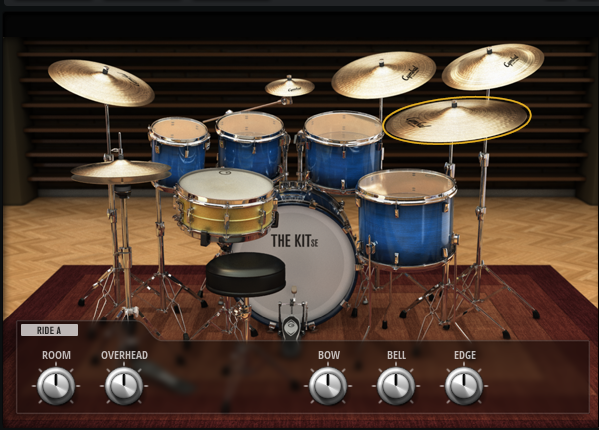The Kit SE

Kick Drum
- Room Level
-
Adjusts the level of the room microphone.
- Overhead Level
-
Adjusts the level of the overhead microphone.
- Tune
-
Adjusts the pitch.
- Attack
-
Adjusts the attack time of the amplifier envelope.
- Hold
-
Adjusts the hold time of the amplifier envelope. Turn the control all the way to the right to play the entire sample.
- Decay
-
Adjusts the decay time of the amplifier envelope.
Snare Drum
- Room Level
-
Adjusts the level of the room microphone.
- Overhead Level
-
Adjusts the level of the overhead microphone.
- Tune
-
Adjusts the pitch.
- Attack
-
Adjusts the attack time of the amplifier envelope.
- Hold
-
Adjusts the hold time of the amplifier envelope. Turn the control all the way to the right to play the entire sample.
- Decay
-
Adjusts the decay time of the amplifier envelope.
Toms
- Room Level
-
Adjusts the level of the room microphone.
- Overhead Level
-
Adjusts the level of the overhead microphone.
- Tune
-
Adjusts the pitch.
- Attack
-
Adjusts the attack time of the amplifier envelope.
- Hold
-
Adjusts the hold time of the amplifier envelope. Turn the control all the way to the right to play the entire sample.
- Decay
-
Adjusts the decay time of the amplifier envelope.
Crash Cymbals, Splash Cymbal, China Cymbal
- Room Level
-
Adjusts the level of the room microphone.
- Overhead Level
-
Adjusts the level of the overhead microphone.
- Choke On/Off
-
A choke effect for cymbals is created by hitting a cymbal, and then grabbing it with the hand, dampening the sound. If Choke is activated, you can choke a cymbal using poly pressure, aftertouch, or note-off events.
- Choke Controller
-
Specifies which MIDI event triggers the choke for the cymbal.
-
Note-off: To play the cymbal, hit the key and hold it. To choke the cymbal, release the key.
-
Aftertouch: To play the cymbal, trigger the corresponding note. To choke the cymbal, send an aftertouch event that is greater than 64.
-
Poly Pressure: To play the cymbal, trigger the corresponding note. To choke the cymbal, send a poly pressure event that is greater than 64.
-
Ride Cymbals
You can play the ride cymbals with the shoulder of the stick on the bell of the cymbal, with the tip of the stick on the bow of the cymbal, or you can hit the cymbal on the edge for a crash sound.
- Room Level
-
Adjusts the level of the room microphone.
- Overhead Level
-
Adjusts the level of the overhead microphone.
- Bow
-
Adjusts the level of the Bow articulation that is triggered with D#2.
- Bell
-
Adjusts the level of the Bell articulation that is triggered with F2.
- Edge
-
Adjusts the level of the Edge articulation that is triggered with B2.
Hihat

- Room Level
-
Adjusts the level of the room microphone.
- Overhead Level
-
Adjusts the level of the overhead microphone.
- Shank, Tip, Foot
-
You can play the hihat with the shoulder of the stick on the edge or with the tip of the stick on the bow of the hihat. When you close the hihat, it produces a foot chick. You can adjust the level for each of these articulations.
-
Shank adjusts the level of the shank hihat articulation that is triggered with F#0 and A#0.
-
Tip adjusts the level of the tip hihat articulation that is triggered with F#1 and A#1.
-
Foot adjusts the level of the foot and pedal hihat articulation that are triggered with G#0/G#1 (Foot) and A0/A-1 (Pedal).
-
- Controller Filter
-
The open state of the closed hihat on A#1 and the shank hihat on A#0 can be controlled with MIDI controller #1 (modulation wheel) or with MIDI controller #4 (foot controller). Use these buttons to filter out any incoming MIDI data for controllers #1 or #4.
For example, activate MW to avoid that any incoming MIDI controller #1 is received from your MIDI keyboard.
- Hihat Open Min/Max
-
These controls adjust the minimum and the maximum opening state of the hihat, that is, they specify how much the hihat can be opened or closed with the corresponding hihat controller.